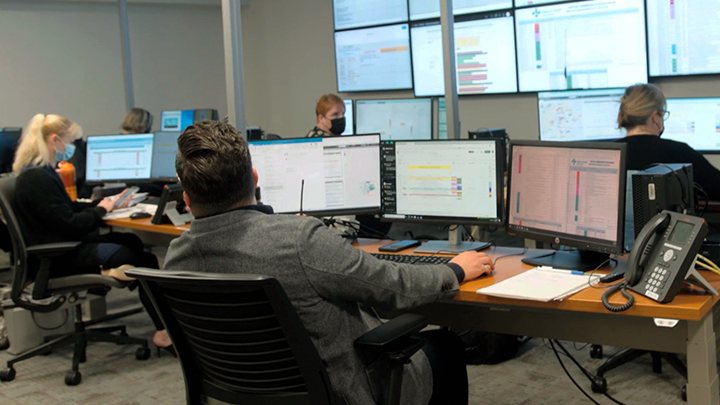
September 23, 2022

The Integrated Operations Centre team reviews real-time data on screens to determine where patients can get the right care, as fast as possible. Photo by Evan Isbister.
Story by Marni Kuhlmann | Photo by Evan Isbister
Patient care can be a complicated undertaking. Getting patients the right care, in a timely manner, is paramount. Thanks to collaborative Integrated Operations Centres (IOCs) in Edmonton and Calgary, that’s happening more efficiently than ever before.
“The idea of the Integrated Operations Centre is to provide kind of a mission control,” says Dr. Kirstie McLelland, acting zone medical director, Edmonton Zone. “Our goal is to get the patient to the right care as fast as we possibly can.”
For many, their healthcare journey starts when someone calls an ambulance. Once paramedics assess the patient and have an idea of what type of care might be required, they contact the IOC to determine best place to take them.
“For example, if someone has chest pain, and it looks suspicious for cardiac, they’ll look not only at the status of the hospital emergency department, not just the closest hospital, but does that hospital have a bed in their coronary care unit? They look at the whole global picture,” says Graeme McAlister, associate executive director, EMS Operations, Edmonton Zone.
The IOC team — whose members include senior paramedics and a Quality Management team of healthcare workers with various clinical backgrounds and frontline experience — analyzes data from acute-care sites, community bed hubs and addiction and mental health resources across the zone. Together, they determine the best site for paramedics to take a patient, where they’ll receive the specific care they need, as fast as possible.
Collaboration is key in the IOC. In addition to real-time data on screens that tracks how many patients are waiting for care in hospitals, the team keeps in regular contact with sites so they can better assess the data.
“We have calls three time a day with our acute sites and community partners, so we have a complete picture of the entire zone and all the patient movement that’s happening,” says Nicole Bonville, patient flow specialist, Integrated Quality Management. “We’re tracking everybody coming in, all the discharges, as well as any capacity that’s available at any of our programs across the zone.”
When patients can quickly get the care they need in hospital, it eases pressure across the system. Data from the IOC show the coordinated effort has helped decrease the amount of time ambulances are waiting at hospital to offload patients. This allows EMS teams to get back to the community faster.
The IOC in Edmonton opened in October 2019, initially as a pilot project. Its success spurred the opening of Calgary’s IOC in May 2022. Both centres are now fully operational 24 hours a day, seven days a week.
“With the IOC and the processes that have been set up, and the high degree of buy-in — not just from leadership but front line staff across all programs including EMS — we’re much better off than we were,” says McAlister.